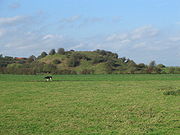
Skipsea Castle
Encyclopedia

Bridlington
Bridlington is a seaside resort, minor sea fishing port and civil parish on the Holderness Coast of the North Sea, in the East Riding of Yorkshire, England. It has a static population of over 33,000, which rises considerably during the tourist season...
, East Riding of Yorkshire
East Riding of Yorkshire
The East Riding of Yorkshire, or simply East Yorkshire, is a local government district with unitary authority status, and a ceremonial county of England. For ceremonial purposes the county also includes the city of Kingston upon Hull, which is a separate unitary authority...
, England
England
England is a country that is part of the United Kingdom. It shares land borders with Scotland to the north and Wales to the west; the Irish Sea is to the north west, the Celtic Sea to the south west, with the North Sea to the east and the English Channel to the south separating it from continental...
on the B1249 road at Skipsea Brough
Skipsea Brough
Skipsea Brough is a hamlet in the East Riding of Yorkshire, England. It is situated approximately north of Hornsea on the B1249 road.It forms part of the civil parish of Skipsea....
. It is a prominent castle
Castle
A castle is a type of fortified structure built in Europe and the Middle East during the Middle Ages by European nobility. Scholars debate the scope of the word castle, but usually consider it to be the private fortified residence of a lord or noble...
. All that remains visible today are the earthworks, having been destroyed by the order of Henry III of England
Henry III of England
Henry III was the son and successor of John as King of England, reigning for 56 years from 1216 until his death. His contemporaries knew him as Henry of Winchester. He was the first child king in England since the reign of Æthelred the Unready...
Skipsea Castle was built in and around 1086, in the years following the Norman Conquest by Drogo de la Bouerer, the First Earl of Holderness, in order to defend against Viking raids. He is related to William the Conqueror through marriage to William's cousin, and participated in the Norman Invasion of England. For this, William the Conqueror placed Drogo's name on the "immortal Roll of Honour of Battle Abbey at Senlac or Hasting", and rewarded Drogo with "so-called 'isle' of Holderness".
Although Drogo built the castle, he eventually fled back to Flanders because death of his wife whom he "unhappily killed". Drogo's hasty flight out of England has given rise to the legend that "Drogo murdered his wife by giving her a poison draught which he led her to believe was a love potion. He then rode a fast horse to the king's court, borrowed a large sum of money from William and took ship to the continent before news of his deeds could reach the court. The ghost of a 'lady in white' is said to haunt Castle Hill".
In the 13th century, William de Froz II, Lord of Holderness rebelled against the king. As a result, in 1221 William de Froz II was excommunicated and Skipsea Castle was destroyed. Eventually, William de Froz II reconciled with King Henry III in 1227. Skipsea Castle was returned to William de Froz II, but without any defences. According to local historians, "the gap in the earthwork known as the Scotch Gap is evidence of this".

